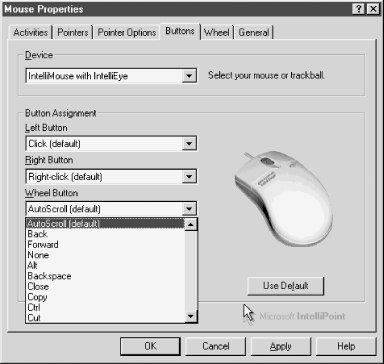20.4 Configuring a Mouse or Trackball
Windows 95/98/NT/2000/XP allows you to
customize how your mouse behaves.
To do so, run the Mouse applet (Start  Settings Settings
 Control Panel Control Panel  Mouse) to display
the Mouse Properties dialog, which for standard mice includes the
following pages: Mouse) to display
the Mouse Properties dialog, which for standard mice includes the
following pages:
- Buttons (Windows 95/98/NT/2000/XP)
-
The Buttons
page in Windows 95/98/NT allows you to configure the mouse for right-
or left-handed use and specify the maximum duration between clicks
that will still be recognized as a double-click. The Windows 2000/XP
Buttons page has the same functions, and also allows you to specify
whether a single click or a double click opens a file or folder.
Changes in this dialog take effect immediately when you click Apply
or OK. IntelliMouse 3.1 and later and recent Logitech mouse drivers
allow or require you to specify the function of individual buttons,
but don't allow you to switch between left- and
right-handed configurations by clicking one option button.
- Pointers (Windows 95/98/NT/2000/XP)
-
The Pointers
page in Windows 95/98/NT allows you to change the appearance of the
mouse cursor. If predefined mouse scheme(s) are installed, selecting
one from the Schemes drop-down list defines all cursor types in one
step. Double-clicking an individual pointer type displays a list of
available cursor icons that can be assigned to that pointer type.
Windows 2000/XP provides the same options, and adds a checkbox to
enable pointer shadow.
- Motion (Windows 95/98/NT/2000/XP)
-
The Motion page
in Windows 95/98/NT allows you to set the speed of the mouse pointer
using the Pointer speed slider. Depending on the mouse driver
installed, other options may also appear on this page, including
Snap-to (automatically move the pointer to the default option button
in dialogs); Pointer trails (display a series of ghost pointers as
the mouse is moved to prevent losing track of the pointer); and
Vanish (hide the mouse pointer while typing). Windows 2000/XP
provides the same options and adds standard Snap to default and
Acceleration settings.
- General (Windows NT only) or Hardware (Windows 2000/XP only)
-
These pages display the type of mouse installed. Clicking the Change
button on the Windows NT General page allows you to select among
alternative installed mouse drivers, or to install a new mouse driver
from a disk supplied by the mouse manufacturer. The Windows 2000/XP
Hardware page instead provides a Troubleshoot button, which invokes
the Mouse Troubleshooter Wizard, and a Properties button, which
simply displays Device Manager properties for the mouse.
Installing a new mouse or an updated mouse driver may add pages and
options to the standard Mouse Properties dialog. For example,
Figure 20-1 shows one of the additional pages that
result from installing the Microsoft IntelliPoint driver supplied
with the Microsoft IntelliMouse with IntelliEye (where do they come
up with these names?). If you install a new mouse driver, locate and
explore the options it provides. The default settings for such things
as wheel definition are probably useful, but one of the alternative
options may better suit your work habits.

|



